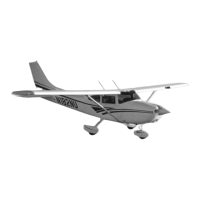SECTION 3 CESSNA
EMERGENCY PROCEDURES MODEL T182T NAV III
GFC 700 AFCS
U.S.
ICING
INADVERTENT ICING ENCOUNTER DURING FLIGHT
1. PITOT HEAT Switch - ON
2. PROP HEAT Switch - ON
3. Turn back or change altitude (to obtain an outside air
temperature that is less conducive to icing)
4. CABIN HT Control Knob - ON (pull full out)
5. DEFROST Control Knob - ON (rotate clockwise) (to obtain
maximum defroster airflow)
6. Increase engine speed to minimize ice build-up on propeller
blades. If excessive vibration is noted, momentarily reduce
engine speed to 2200 RPM with the propeller control, and then
rapidly move the control forward.
• Cycling the RPM flexes the propeller blades and high
RPM increases centrifugal force, causing ice to shed
more rapidly.
• If the amber PROP HEAT annunciator comes ON, cycle
the PROP HEAT Switch OFF then ON. If it comes on
again, place the PROP HEAT Switch to OFF and
continue using the RPM cycling technique to minimize
ice build up on the propeller blades. Have propeller heat
system inspected by qualified personnel before next
flight.
7. Watch for signs of induction air filter icing. A loss of manifold
pressure could be caused by ice blocking the air intake filter.
Adjust the throttle as necessary to hold manifold pressure.
Adjust mixture as necessary for any change in power settings.
8. Plan a landing at the nearest airport. With an extremely rapid ice
build-up, select a suitable off airport landing site.
9. With an ice accumulation of 0.25 inch or more on the wing
leading edges, be prepared for significantly higher power
requirements, higher approach and stall speeds, and a longer
landing roll.
10. Leave wing flaps retracted. With a severe ice build-up on the
horizontal tail, the change in wing wake airflow direction caused
by wing flap extension could result in a loss of elevator
effectiveness.
(Continued Next Page)
T182TPHBUS-01
3-14

